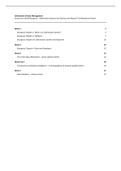Samenvatting
Information and Data Management (IDM) Summary (THEORY) - GRADE 9,0
- Instelling
- Universiteit Van Amsterdam (UvA)
Summary of the material for the final exam (2021) for Information and Data Management (IDM). Includes notes of chapters 1, 3 and 10 of David Bourgeois’s “Information Systems for Business and Beyond” (2019) and notes on the mandatory articles ("The Truth About Blockchain", "The Business of A...
[Meer zien]





